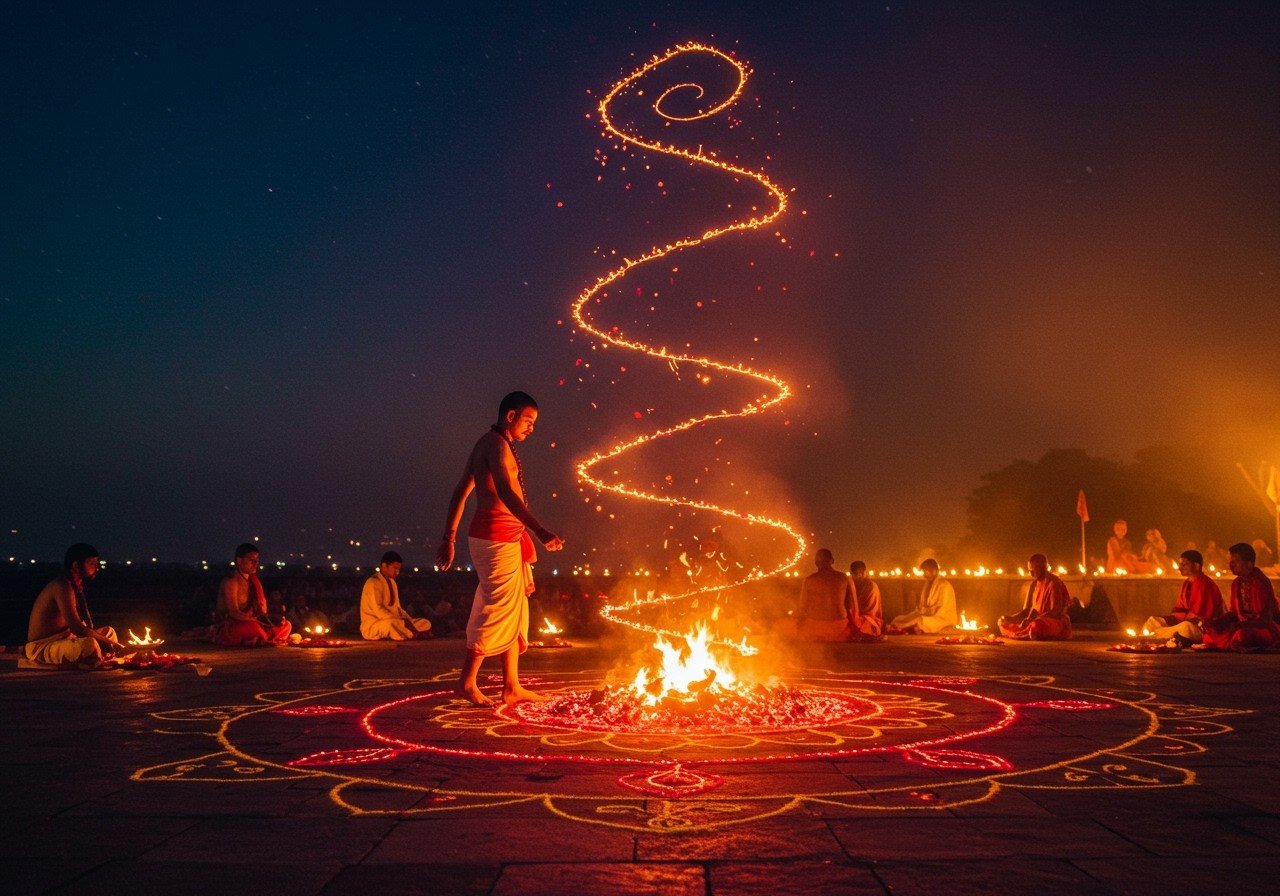
For centuries, the act of firewalking—treading barefoot across a bed of glowing embers—has captivated and mystified people across cultures and continents. In India, this ancient practice is deeply intertwined with spirituality and tradition, often seen as a powerful display of faith, courage, and connection to the divine. While seemingly miraculous, the science behind firewalking is firmly rooted in physics and the understanding of heat transfer. Let’s delve into the fascinating world of firewalking, exploring the science that makes it possible, the cultural rituals that surround it, and the essential steps to participate safely.
The Science Behind the Spectacle
The seemingly impossible feat of firewalking is grounded in scientific principles, primarily the concept of thermal conductivity. Wood embers, the typical medium for firewalking, are surprisingly poor conductors of heat. This means that while their surface temperature is indeed high, they don’t transfer heat rapidly to your feet. Several factors contribute to this:
- Low Thermal Conductivity of Embers: Wood embers, unlike metals, don’t transfer heat quickly. This slow transfer rate gives your feet enough time to cross without sustaining major burns. The ash layer further insulates your feet from the heat.
- Brief Contact Time: A steady, brisk pace is crucial. The less time your feet are in contact with the embers, the less heat is transferred. Think of it like quickly touching a hot stove – a fleeting touch is less likely to burn than a prolonged one.
- Insulating Ash Layer: The layer of ash covering the embers acts as an additional barrier, further reducing the heat reaching your feet. This ash layer provides a protective buffer, minimizing the impact of the hot embers.
- Limited Heat Capacity: Embers have a relatively low heat capacity, meaning they can’t release a vast amount of heat all at once. Each step absorbs some heat, but the embers cool down quickly upon contact, limiting the potential for burns. Quick steps prevent the embers from transferring their full heat potential.
These factors, combined with the Leidenfrost effect (where a layer of sweat or moisture on the feet can briefly create a protective vapor barrier), contribute to the science behind safe firewalking.
Cultural Significance and Rituals in India
In India, firewalking transcends mere spectacle; it is a deeply spiritual and cultural practice, often associated with festivals like Thimithi. This festival, dedicated to Draupadi Amman, sees devotees walk across a bed of embers as an act of devotion, believing it cleanses them of sins and fulfills vows. It’s a testament to their faith and a powerful expression of community solidarity.
The rituals surrounding firewalking vary across regions and communities, often involving prayer, fasting, and offerings to deities. These sacred rituals prepare participants mentally and spiritually, fostering a sense of connection and reverence.
Prioritizing Safety in Firewalking
While firewalking is rooted in science and faith, safety remains paramount. A well-prepared firewalk requires experienced facilitators who understand the nuances of ember preparation, ensuring an even distribution of heat and proper cooling. They also guide participants through the mental and emotional aspects of the experience, promoting calm and focused walking.
Maintaining a steady, deliberate pace is crucial. Hesitation or lingering on the embers increases the risk of burns. Choosing a reputable firewalking event with trained facilitators is the best way to ensure a safe and meaningful experience.
A Step-by-Step Guide to Safe Firewalking
If you’re considering participating in a firewalking event, here are some essential safety tips:
- Choose a Reputable Event: Opt for events led by experienced facilitators who prioritize safety and provide thorough instructions.
- Steady and Deliberate Steps: Walk at a steady pace, avoiding running or hesitating. This minimizes the contact time between your feet and the embers.
- Mental Focus: Mental preparation is key. Stay calm, focused, and present. Visualize a successful walk. Your mental state plays a significant role in your experience.
- Follow Instructions: Listen attentively to the facilitator’s guidance. They are there to ensure your safety and a positive experience.
Dispelling the Myths Surrounding Firewalking
Over time, myths and misconceptions have shrouded firewalking in an air of mystery. Some believe that only individuals with supernatural powers can perform this feat unharmed. The reality is that firewalking is accessible to anyone willing to understand the science and follow safety guidelines.
Another common myth portrays firewalking as inherently dangerous. It’s not the act itself, but rather the lack of proper preparation and guidance that poses risks. With knowledge and awareness, firewalking becomes a testament to human resilience and our understanding of natural laws.
Poojn.in: Supporting Your Spiritual Journey
At Poojn.in, we understand the significance of rituals like firewalking in Indian culture. We offer a wide selection of authentic puja items to enhance your spiritual practices. From premium-quality guggul and dhoop to sacred woods and other essential materials, we provide everything you need for a meaningful and traditional experience. Visit www.poojn.in to explore our complete collection of ritual items and embark on your spiritual journey with confidence and ease.
- Find the Perfect Puja Kit: Preparing for a puja can be overwhelming. Learn how to find the right puja kit for your specific needs with our helpful guide: How to Find the Best Puja Kit for Your Festival Needs. This resource helps ensure you have everything required for a fulfilling and authentic puja experience.
- Avoid Common Puja Mistakes: Ensure your puja is performed correctly with our insightful article on common mistakes to avoid: 10 Common Puja Mistakes Devotees Make and How to Correct Them. Following these guidelines will help you conduct your puja with respect and adherence to traditional practices.
Embracing Tradition with Knowledge and Respect
Firewalking in India is a powerful symbol of faith, courage, and cultural heritage. By understanding both the scientific principles and the spiritual significance behind this ancient practice, we can approach it with the respect and awareness it deserves. Safety should always be the foremost concern, and proper preparation and guidance are essential for a positive and meaningful firewalking experience. At Poojn.in, we’re committed to supporting your spiritual journey by providing authentic and high-quality puja items that honor tradition and enhance your connection to the divine.
Common Questions about Firewalking
How does firewalking actually work? The science behind firewalking lies in the low thermal conductivity of embers and the short contact time. Embers don’t transfer heat quickly, and a brisk walk minimizes the heat absorbed by your feet. The Leidenfrost effect, where moisture creates a temporary vapor barrier, also plays a role, though it’s not the primary factor.
Is firewalking safe for everyone? Firewalking can be safe when conducted under proper supervision and with careful preparation. However, it’s essential to listen to the instructions of experienced facilitators and to be aware of the potential risks involved. Individuals with certain health conditions should consult a medical professional before participating.
Is firewalking a dangerous practice? Firewalking can be dangerous if proper safety protocols aren’t followed. Choosing a reputable event with experienced facilitators is crucial. They ensure the embers are properly prepared and guide participants through the process, minimizing the risks.
Why doesn’t firewalking burn your feet? The combination of low thermal conductivity, short contact time, and the insulating layer of ash protects your feet from burns. Walking quickly prevents the embers from transferring enough heat to cause significant damage. It’s like briefly touching a hot surface – a quick touch is less likely to burn than prolonged contact.
Can firewalking burn your feet? While firewalking is generally safe when done correctly, burns can occur if precautions aren’t taken. Walking too slowly, hesitating, or not following the facilitator’s instructions can increase the risk of burns. Following safety guidelines and staying mentally focused are crucial for a safe experience.
For those seeking deeper insights into meditation practices, Poojn.in offers valuable resources. Explore Common Meditation Challenges: How to Overcome Them to enhance your meditation practice. Discover effective Breathing Exercises for Meditation to achieve inner peace and tranquility. These guides offer practical tips and techniques for both beginners and experienced practitioners.


